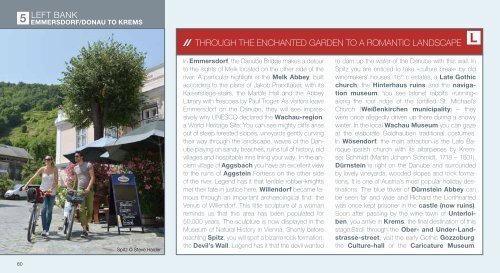Danube Cycle Path from Passau to Bratislava
Create successful ePaper yourself
Turn your PDF publications into a flip-book with our unique Google optimized e-Paper software.
5<br />
LEFT BANK<br />
EMMERSDORF/DONAU TO KREMS<br />
// THROUGH THE ENCHANTED GARDEN TO A ROMANTIC LANDSCAPE<br />
Spitz © Steve Haider<br />
In Emmersdorf, the <strong>Danube</strong> Bridge makes a de<strong>to</strong>ur<br />
<strong>to</strong> the sights of Melk located on the other side of the<br />
river. A particular highlight is the Melk Abbey, built<br />
according <strong>to</strong> the plans of Jakob Prandtauer, with its<br />
Kaiserstiege-stairs, the Marble Hall and the Abbey<br />
Library with frescoes by Paul Troger. As visi<strong>to</strong>rs leave<br />
Emmersdorf on the <strong>Danube</strong>, they will see impressively<br />
why UNESCO declared the Wachau-region,<br />
a World Heritage Site: You can see mighty cliffs arise<br />
out of steep forested slopes, vineyards gently curving<br />
their way through the landscape, waves of the <strong>Danube</strong><br />
playing on sandy beaches, ruins full of his<strong>to</strong>ry, old<br />
villages and hospitable inns lining your way. In the ancient<br />
village of Aggsbach you have an excellent view<br />
<strong>to</strong> the ruins of Aggstein Fortress on the other side<br />
of the river. Legend has it that terrible robber-knights<br />
met their fate in justice here. Willendorf became famous<br />
through an important archaeological find: the<br />
Venus of Willendorf. This little sculpture of a woman<br />
reminds us that this area has been populated for<br />
50,000 years. The sculpture is now displayed in the<br />
Museum of Natural His<strong>to</strong>ry in Vienna. Shortly before<br />
reaching Spitz, you will spot a bizarre rock formation:<br />
the Devil’s Wall. Legend has it that the devil wanted<br />
<strong>to</strong> dam up the water of the <strong>Danube</strong> with this wall. In<br />
Spitz you are enticed <strong>to</strong> take »culture break« by old<br />
winemakers’ houses, 16 th c estates, a Late Gothic<br />
church, the Hinterhaus ruins and the navigation<br />
museum. You see (s<strong>to</strong>ne) rabbits »running«<br />
along the roof ridge of the fortified St. Michael’s<br />
Church (Weißenkirchen municipality) – they<br />
were once allegedly driven up there during a snowy<br />
winter. In the local Wachau Museum you can gaze<br />
at the elaborate Goldhauben traditional costumes.<br />
In Wösendorf, the main attraction is the Late Baroque<br />
parish church with its altarpieces by Kremser<br />
Schmidt (Martin Johann Schmidt, 1718 – 1801).<br />
Dürnstein is right on the <strong>Danube</strong> and surrounded<br />
by lovely vineyards, wooded slopes and rock formations,<br />
It is one of Austria’s most popular holiday destinations.<br />
The blue <strong>to</strong>wer of Dürnstein Abbey can<br />
be seen far and wide and Richard the Lionhearted<br />
was once kept prisoner in the castle (now ruins).<br />
Soon after passing by the wine <strong>to</strong>wn of Unterloiben,<br />
you arrive in Krems, the final destination of this<br />
stage.Stroll through the Ober- and Under-Landstrasse-street,<br />
visit the early Gothic Gozzoburg,<br />
the Culture-hall or the Caricature Museum.<br />
80

















